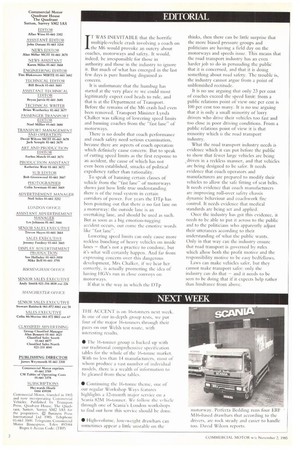EDITORIAL
Page 4

If you've noticed an error in this article please click here to report it so we can fix it.
iT WAS INEVITABLE that the horrific multiple-vehicle crash involving a coach on the M6 would provoke an outcry about coaches, motorways and safety. It would, indeed, be irresponsible for those in authority and those in the industry to ignore it. But much of what has emerged in the last few days is pure humbug disguised as concern.
It is unfortunate that the humbug has started at the very place re we could most legitimately expect cool heads to rule, and that is at the Department of Transport. Before the remains of the M6 crash had even been removed, Transport Minister Lynda Chalker was talking of lowering speed limits and banning coaches from the "fast lane" of motorways.
There is no doubt that coach performance and coach safety need serious examination, because there are aspects of coach operation which definhely cause concern. But to speak of cutting speed limits as the first response to an accident, the cause of which has not even been established, smacks of political expediency rather than rationality.
To speak of banning certain classes of vehicle from the "fast lane" of motorways shows just how little true understanding there is of the road system in certain corridors of power. For years the DTp has been pointing out that there is no fast lane on a motorway: the outside lane is an overtaking lane, and should be used as such. But as soon as a big emotion-tugging accident occurs, out come the emotive words like "fast lane".
Lowering speed limits can only cause more reckless bunching of heavy vehicles on inside lanes — that's not a practice to condone, but it's what will certainly happen. And far from expressing concern over this dangerous development, Mrs Chalker, if we hear her correctly, is actually promoting the idea of having HGVs run in close convoys on motorways.
If that is the way in which the DTp thinks, then there can be little surprise that the more biased pressure groups and politicians are having a field day on the motorways and speeds issue. This means that the road transport industry has an even harder job to do in persuading the public that it is concerned, and that it is doing something about road safety. The trouble is, the industry cannot argue from a point of unblemished rectitude.
It is no use arguing that only 23 per cent of coaches exceed the speed limit: from a public relations point of view one per cent is 100 per cent too many. It is no use arguing that it is only a small minority of lorry drivers who drive their vehicles too fast and too close in poor driving conditions. From a public relations point of view it is that minority which is the road transport industry.
What the road transport industry needs is evidence which it can put before the public to show that fewer large vehicles arc being driven in a reckless manner, and that vehicles are being designed to be safer. It needs evidence that coach operators and manufacturers arc prepared to modify their vehicles to allow the safe fitting of scat belts. It needs evidence that coach manufacturers are improving roll-over safety chassis dynamic behaviour and coachwork fire control. It needs evidence that medical standards are being set and applied.
Once the industry has got this evidence, it needs to be able to put it across to the public and to the politicians who apparently adjust their utterances according to their understanding of what the public wants. Only in that way can the industry ensure that road transport is governed by rules which allow both the profit motive and the responsibility motive to be easy bedfellows.
Laws can make vehicles safer, but they cannot make transport safer: only the industry can do that — and it needs to be seen to be doing that if it expects help rather than hindrance from above.












































































































